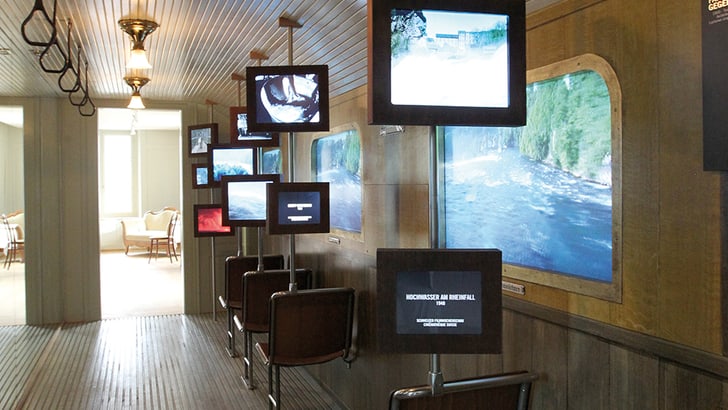Historama room
Immerse yourself in times gone by! Our Historama room at Schloss Laufen combines historical charm with modern comfort. Enjoy unique insights into the history of the Rhine Falls - right on your doorstep.

Room 1: Bleuler Hall
The Bleuler school of painting around 1848. Louis Bleuler's vedute (Italian veduta: view) - realistic depictions of landscapes - are popular. His wife Antoinette sold them throughout Europe and to Rhine Falls tourists.
Room 2: Everyday life at the Rhine Falls
The cosmographer Sebastian Münster (1488-1552) published Cateracta Rheni, the first woodcut of the Rhine Falls, in his Cosmographia of 1544. (Cosmography: description of the earth, forerunner of geography)
Room 3: Dutch corner
Celebrities on a visit: Emperor Ferdinand l visits the Rhine Falls with 300 people in 1563. An explosive proposal in 1609: Dutch merchants show how the rafting obstacle in front of the castle could be blown up.
Room 4: Waibel Chamber
Another explosive attempt: in 1821, engineer J. J. Waibel submits a project to remove the Rhine Falls.
Room 5: Romantic Room
Time and again, personalities are guests. Between 1777 and 1814 - at the time of the so-called Grand Tour - the German Emperor Joseph ll, Tsar Alexander l and J.W. von Goethe, among others, visit Schloss Laufen.
Room 6: Industrial and railroad (T)raum
Industrialization significantly changes the surroundings of Schloss Laufen between 1840 and 1860. The opening of the Rhine Falls Railway brought a real hotel boom.
Room 7: Belle Epoque Suite
Tourism at the Rhine Falls experienced its heyday. In 1867, Austrian Emperor Franz Josef I and his wife Elisabeth ("Sisi") spent the night at the Hotel Schweizerhof, very close to the waterfall.
Room 8: Wedding at the Rhine Falls
Schloss Laufen, with its ambience, has always been a place of festivities and celebrations. In 1864, Victorine Louise Bleuler - the daughter of the veduta painter Louis Bleuler - married the hotelier and tourism pioneer Franz Wegenstein here.
Room 9: Aluminum Room
The industrialist Johann Georg Neher (1788-1858) holds the rights to exploit the hydropower at the Rhine Falls, today's SIG, and an aluminum smelter is built. However, one of his company's power plant projects fails in 1888.
Room 10: Journey into the present
Historical film footage shows the political and tourist developments between 1912 and 2009, including the demonstration against a barrage at Rheinau in the 1950s and mass tourism from 1960 onwards.
Room 11: Chair room
They were the subject of the tour, the pioneers and lateral thinkers at the Rhine Falls. A chair is dedicated to each of these personalities. If you take a seat, you can find out more about the lives of these extraordinary people.
